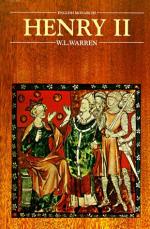money, and introduced trade. But they were powerless
to affect Irish civilization. The tribal system
survived in its full strength, and Ireland remained
divided between two races, two languages, two civilizations
in different stages of progress, two separate communities
ruled by their own laws, and two half-completed ecclesiastical
systems, for the Danish Church long looked, as the
Irish had never done, to the Archbishop of Canterbury
as their head. Earnest attempts had already been
made by Hadrian’s predecessor to bring the Irish
into closer connection with the see of Rome. In
1152 a papal legate had carried out a great reform
by which four archbishops, wholly independent of Canterbury
and receiving their palls from Rome, were set over
four provinces. But still no Peter’s Pence
were paid to Rome; Roman canon law, Roman ritual,
the Roman rules of marriage, had no authority; the
Roman form of baptism was replaced by a tradition which
made the father dip his new-born child three times
in water, or, if he were a rich man, in milk; there
was no payment of tithes; clerks were taxed like laymen
when a homicide occurred; Irish nobles still demanded
hospitality from religious houses, and claimed, according
to ancient custom, provisions from towns on Church
domains. Hadrian himself had long been interested
in Irish affairs. The religious houses which the
Irish maintained in Germany kept up communication
with Pope and Emperor; an Irish abbot at Nuremberg
was chaplain to the Emperor Frederick; one of Hadrian’s
masters at Paris had been a monk from the Irish settlement
in Ratisbon, and as Pope he still remembered the Irish
monk with warm affection. When he was raised
to the Papacy in the very year of Henry’s coronation,
one of his first cares was to complete the organization
of Christendom in the West by bringing the Irish Church
under Catholic discipline.
Henry, on his part, was only too eager to accept his
new responsibility, and less than a year after his
coronation he called a council to discuss the conquest
of Ireland. The scheme was abandoned on account
of its difficulties, but the question was later raised
again in another form. Diarmait Mac Murchadha
(in modern form Jeremiah Murphy), King of Leinster,
had carried off in 1152 the wife of the chief of Breifne
(Cavan and Leitrim). A confederation was formed
against him under Ruaidhri (or Rory), King of Connaught,
and he was driven from the island in 1166. “Following
a flying fortune and hoping much from the turning of
the wheel,” he fled to Henry in Aquitaine, did
homage to the English king for his lands, and received
in return letters granting permission to such of Henry’s
servants as were willing to aid him in their recovery.
Diarmait easily found allies in the nobles of the Welsh
border, in whose veins ran the blood of two warlike
races. It was by just such an enterprise as this
that their Norman fathers and grandfathers had won
their Welsh domains. From childhood they had been




